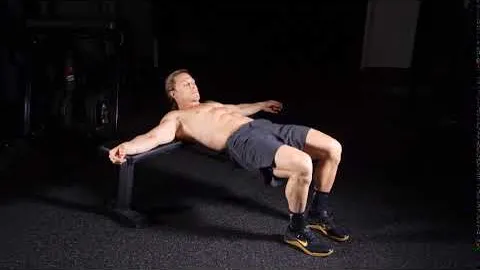
Looking to strengthen your glutes and lower body without the need for fancy gym equipment? Look no further than the bodyweight hip thrust exercise! This simple yet effective movement targets the gluteal muscles, hamstrings, and quadriceps while also improving core stability. In this guide, we'll walk you through how to properly perform the bodyweight hip thrust exercise, its benefits, variations, and safety considerations.
The bodyweight hip thrust exercise is a compound movement that involves thrusting the hips vertically while seated on the ground. This exercise primarily targets the gluteus maximus, the largest muscle in the gluteal group. By isolating and activating the glute muscles, the bodyweight hip thrust exercise can lead to improved strength, power, and stability.
To perform the bodyweight hip thrust exercise, follow these step-by-step instructions:
Set Up: Begin by sitting on the ground with your upper back against a sturdy bench or elevated surface. Your knees should be bent, and your feet should be planted firmly on the ground, hip-width apart. Ensure that your upper back, shoulders, and head are resting comfortably against the bench.
Engage the Core: Activate your core muscles by pulling your belly button in towards your spine. This will help stabilize your spine throughout the movement.
Thrust Up: While maintaining the core engagement, press your feet into the ground and lift your hips off the floor. Aim to create a straight line from your knees to your shoulders and avoid hyperextending your spine.
Squeeze at the Top: At the top of the movement, squeeze your glutes tight for a brief moment to maximize muscle activation.
Lower Down: Gently lower your hips back down towards the ground, maintaining control and alignment throughout the descent.
Repeat: Perform the desired number of repetitions, focusing on proper form and maintaining the engagement of your core and glute muscles throughout the entire exercise.
Incorporating the bodyweight hip thrust exercise into your fitness routine can offer a range of benefits, including:
Gluteal Activation: The bodyweight hip thrust exercise specifically targets and activates the glute muscles, contributing to overall hip and lower body strength.
Improved Lower Body Strength: Regularly performing the bodyweight hip thrust exercise can enhance strength in the gluteal muscles, hamstrings, and quadriceps, which are essential for athletic performance and everyday movements.
Enhanced Hip Extension: By targeting the gluteal muscles, the bodyweight hip thrust exercise can enhance hip extension, which plays a crucial role in activities like walking, running, and jumping.
Increased Core Stability: Throughout the exercise, maintaining core engagement is essential. This helps stabilize the spine and improve overall core strength and stability.
Injury Prevention: Strengthening the gluteal muscles through the bodyweight hip thrust exercise can contribute to better pelvic stability, reducing the risk of lower back pain and various lower body injuries.
Once you have mastered the basic bodyweight hip thrust exercise, you can incorporate variations to increase the challenge or target different muscle groups. Here are a few variations to consider:
Single-Leg Hip Thrust: Perform the exercise as usual, but with one leg extended straight out in front of you. This variation increases the demand on the glute muscles while also challenging your balance and stability.
Band-Resisted Hip Thrust: Place a resistance band just above your knees and perform the exercise as usual. This variation adds extra resistance, further engaging your glutes and promoting muscle growth.
Weighted Hip Thrust: Once you are comfortable with the bodyweight hip thrust exercise, you can add external weight, such as a barbell or dumbbells, to increase resistance.
Elevated Feet Hip Thrust: Place your feet on an elevated platform or bench, increasing the range of motion and intensifying the exercise.
As with any exercise, it's important to prioritize safety and proper form when performing the bodyweight hip thrust exercise. Here are a few key considerations:
Maintain Proper Spinal Alignment: Avoid excessive hyperextension of the spine during the exercise. Focus on creating a straight line from your knees to your shoulders.
Start with Bodyweight: Begin with the bodyweight hip thrust exercise before progressing to variations or adding external weight. This allows you to develop proper form and build a foundation of strength.
Listen to Your Body: If you experience any pain or discomfort during the exercise, stop immediately. Consult with a healthcare professional if necessary.
Progress Gradually: Gradually increase the intensity, repetitions, or resistance as your strength and stability improve. Don't rush the progression to avoid potential injuries.
In conclusion, the bodyweight hip thrust exercise is a valuable addition to any lower body strengthening routine. By properly activating and targeting the gluteal muscles, you can improve strength, stability, and overall lower body performance. Remember to focus on proper form, start with bodyweight, and gradually progress as your strength improves. Incorporate the bodyweight hip thrust exercise into your fitness routine and reap the benefits of stronger glutes and a more powerful lower body.
If you're looking for a gym, fitness club or yoga studio, you've come to the right place.
You can find information about gyms in your area. Browse catalog of gyms and find gyms with classes which are you looking for.
On gym page you can find simple information like address, phone or website. You can find list of available classes. You can check availability of personal training or small group classes. On place page you can also see information about open hours.
You can find gyms near you with amenities, courts, studios and equipments.
Use our map to find gym at your city or district.
In Gym Navigator you can find list of exercises with movies for many body parts.
You can browse exercises catalog and find exercises the best of you.
You can also find exercises grouped into workout plans, which you can use to improve you body. Each routine show you exercises one by one and give you possibility to count you progress and count down rest time.